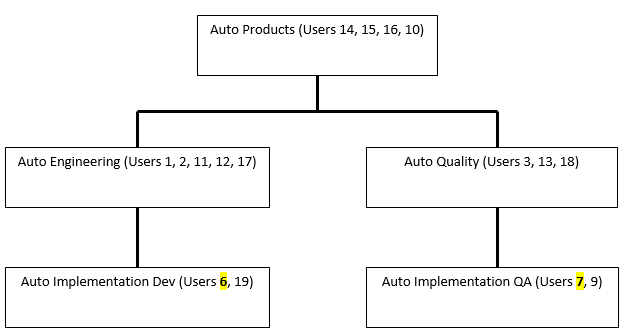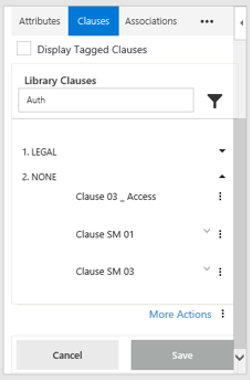| Line 19: | Line 19: | ||
[[Edit_a_Clause|Edit a Clause]] | [[Edit_a_Clause|Edit a Clause]] | ||
| + | |||
== Access Control on Clauses == | == Access Control on Clauses == | ||
| Line 45: | Line 46: | ||
*Add User 6 as a ''Contributor ''to the Team and give access to Clause 01 and Clause 03. User can now search, access and make updates to these Clauses now. | *Add User 6 as a ''Contributor ''to the Team and give access to Clause 01 and Clause 03. User can now search, access and make updates to these Clauses now. | ||
*Add User 6 to the Team by provisioning Event Rules. You can now define conditions on Clause entity attributes such as ''Clause Created, Clause Updated, Clause Sent For Approval, Clause Approved,'' etc. | *Add User 6 to the Team by provisioning Event Rules. You can now define conditions on Clause entity attributes such as ''Clause Created, Clause Updated, Clause Sent For Approval, Clause Approved,'' etc. | ||
| − | <div class="image-green-border">[[File:SP7 Clauses and Access Control 4.png|SP7 Clauses and Access Control 4]]</div> <div class="image-green-border">[[File:SP7 Clauses and Access Control 5.png|SP7 Clauses and Access Control 5]]</div> | + | <div class="image-green-border">[[File:SP7 Clauses and Access Control 4.png|SP7 Clauses and Access Control 4]]</div> <div class="image-green-border"> </div> <div class="image-green-border">[[File:SP7 Clauses and Access Control 5.png|SP7 Clauses and Access Control 5]]</div> |
Let’s consider the same example as above, User 6 can also create a Template for the same Contract Type in ICM or using Word Add-in:<br/> 1. '''Create''' a Template using Word Add-in.<br/> 2. '''Click''' the ''Clauses'' tab.<br/> 3. '''Enter''' a search criterion in the ''Library Clauses'' field. The Clauses accessible to the user are listed. <br/> 4. '''Preview''' the Template. Clauses are listed depending on the Rule based conditions. | Let’s consider the same example as above, User 6 can also create a Template for the same Contract Type in ICM or using Word Add-in:<br/> 1. '''Create''' a Template using Word Add-in.<br/> 2. '''Click''' the ''Clauses'' tab.<br/> 3. '''Enter''' a search criterion in the ''Library Clauses'' field. The Clauses accessible to the user are listed. <br/> 4. '''Preview''' the Template. Clauses are listed depending on the Rule based conditions. | ||
<div class="image-green-border">[[File:SP7 Clauses and Access Control 6.PNG|SP7 Clauses and Access Control 6]]</div> | <div class="image-green-border">[[File:SP7 Clauses and Access Control 6.PNG|SP7 Clauses and Access Control 6]]</div> | ||
Revision as of 09:31, 23 December 2018
Contents
Clause Management
A Clause is a distinct article or provision in a Contract or Agreement, or other formal or legal written documents. In ICM, you can create new Clauses for various Contract Types, and use these Clauses while creating Templates.
Using the Clause Management feature, you can perform following tasks:
Search a Clause
Create a Clause
Approve/Reject a Clause
Send a Clause for Approval
Approve/Reject a Clause
Edit a Clause
Access Control on Clauses
The access and visibility of Clauses is restricted through a technical configuration in the following ways:
- By restricting access control to the ICM Clause Library based on the Organization level or by adding the user to a Clause Team based on User Groups. This allows the Administrator to selectively provide view access as compared to all users having access to the Clauses tab being able to view and access all clauses in ICM’s Clause Library. So, if a user is not part of Clause Team, only the Clause tile will be displayed but clauses will not be visible to the user even though View privileges have been given in the Security Group.
- By provisioning Event Rules by adding members to the Clause Team thus saving time of manually adding users to the Team. You can now define conditions on Clause entity attributes such as Clause Created, Clause Updated, Clause Sent For Approval, Clause Approved, etc.
- By providing support for the Observer role in the Clause Library and giving read only access using Role Action Mapping for Clause Entity.
- By providing Clause Team-based access filtering at the Template and Agreement level using Word Add-in (.Net and .JS). When editing an Agreement, the clauses are displayed on the Agreement Clauses tab, Parent Agreement Clauses, Library based on the configuration.
Let's consider an example of Access Control on Clauses using the Organization path screenshot below:
As User 7 create the following primary clauses – Clause 01, Clause 02, Clause 03 andClause 04. To do this:
1. Click the Clause Management tile on the Dashboard.
2. Click the Create Clause tile. This opens the Create Clause page.
3. Enter the details for the Clause:
- Enter the Name of the Clause. For example, Clause 01.
- Enter the remaining details for the Clause.
4. Click Next. This open the Team tab.
5. Add a member to the team by clicking the Add icon.
6. Click Next. This opens the Verify tab and verify the Clause details on the page.
7. Click Create to create Clause 01. This opens the Clause Details page with a preview of the Clause document.
8. Click the Send for Approval button to send it for approval. The Clause will be listed on the Clause Management Index page.
9. Similarly, create Clause 02, Clause 03 and Clause 04 as primary clauses. All users in Auto Products, all users in Auto Quality, and all users in Auto Implementation QA can access all the clauses.
10. Add User 6to the Team in one of the following ways:
- Add User 6 as an Observer to the Team and give access to Clause 01 and Clause 03. User can search and view these Clauses, but cannot make any updates to them.
- Add User 6 as a Contributor to the Team and give access to Clause 01 and Clause 03. User can now search, access and make updates to these Clauses now.
- Add User 6 to the Team by provisioning Event Rules. You can now define conditions on Clause entity attributes such as Clause Created, Clause Updated, Clause Sent For Approval, Clause Approved, etc.
Let’s consider the same example as above, User 6 can also create a Template for the same Contract Type in ICM or using Word Add-in:
1. Create a Template using Word Add-in.
2. Click the Clauses tab.
3. Enter a search criterion in the Library Clauses field. The Clauses accessible to the user are listed.
4. Preview the Template. Clauses are listed depending on the Rule based conditions.
Creating an Agreement using the Template created in Word Add-in:
1. Create an Agreement using this template. User 6 can see the entire Agreement even though access to Clause 02 and Clause 04 is not given.
2.Click the Agreement Clauses tab. All clauses are visible as they are not access controlled at the Agreement level.
3. Click Show Clause to view the clause information.
4. Download the Agreement. User can see all the Library Clauses, Agreement Clauses and Parent Agreement Clauses.
5. Add an Alternate Clause to Clause 04.
User 6 cannot see this clause as Clause 04 is a primary clause, hence the user who does not have access to the primary clause will not be able to see the Alternate Clauses. However, the Alternate Clauses are still visible on the Agreement Clauses tab.





